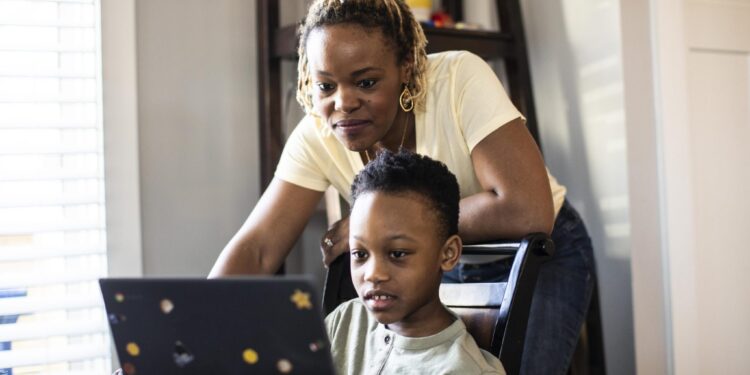
Much has been said about how the pandemic shutdown not only robbed kids of vital socialization and education, but also left them vulnerable to declining mental health, amplifying already debilitating struggles.
But a new study, published in the journal JAMA Network Open, has also found a surprise: that the early COVID isolation may have actually helped improve, ever so slightly, the mental health struggles of some children.
“We would have expected a lot of declines in mental health over time,” one of the lead authors, Kaja LeWinn, professor at the University of California School of Medicine, San Francisco, tells Fortune. “We actually found some improvements, specifically for kids with significant behavioral problems.”
Kids who started out with significant mental problems improved
The study was based on the self-reported responses of over 1,200 children ages 6 to 17 who completed a checklist, before and during the pandemic, from the National Institute of Health’s Environmental influences on Child Health Outcomes (ECHO) Program. LeWinn and fellow lead author Courtney Blackwell, professor at Northwestern University Feinberg School of Medicine, pursued their research to understand what kind of impact the pandemic had on children, with the data from pre- and mid-pandemic.
Of the participants, those who entered the pandemic with significant, or “clinically meaningful” mental health problems—including anxiety, depression, or ADHD behaviors such as struggling to focus in class—saw the greatest improvements, what researchers called “medium decreases” of their pre-pandemic numbers, of about 3 to 5%. And while low-income and Black children experienced smaller decreases in ADHD compared with higher income and white children—about 0.5%—even the smaller decreases, LeWinn said, can have an impact.
She added that while some of their findings supported other research on this topic—such as girls faring worse than boys and the benefit of remote learning for some—they expanded ways of understanding kids’ mental health by studying specific demographics to find that not all kids struggled equally, or at all, with their mental health.
“This is adding some nuance to the picture,” LeWinn says.
The largest improvements were reflected in children who had more externalizing mental health behaviors, more prone to outbursts or trouble paying attention, LeWinn says.
LeWinn and Blackwell don’t know the exact reasons why some children saw improvements, but they have some ideas.
For the kids who act out most at school, LeWinn said, being in class can be pretty stressful. “It can be a very challenging environment,” LeWinn says. “You’re being asked to pay attention constantly, and it’s demanding.”
LeWinn and Blackwell think that a break from those conditions due to the shutdown may have been helpful, leading to the improvements they saw.
“If you’re really anxious, being able to stay at home might relieve some of that stress, some of that pressure of being at school,” Blackwell adds.
For other kids, COVID-19 presented more challenges
LeWinn said the kids included were a fairly diverse bunch, with 52% identifying as white, 32% as Black, 12% as multiracial, 3% as another race, and nearly 10% as Hispanic. She said they came from diverse economic backgrounds as well.
With such a variety of experiences, not every child will experience improvements to their mental health, especially in a time as difficult as the pandemic.
“What we were trying to show, at least in these exploratory ways, was that the pandemic wasn’t the same for everybody,” Blackwell tells Fortune.
Of the kids whose mental health problems increased during the pandemic, Blackwell and LeWinn found they were more often experiencing internalized issues, such as anxiety and depression.
LeWinn wanted to emphasize that while their findings reflected different mental health experiences for kids, they were paving the way for future research to dive into those differences and why they’re occurring.
Blackwell and LeWinn realized that the pandemic took children out of school, creating an unusual situation that inspired their research into how COVID-19 impacted kids’ mental health—a topic that still begs further study.
“We really just wanted to provide some insights into what might be happening and stimulate some future work,” LeWinn said. “It really probably is not the same story for all kids and some may be doing very differently than others.”
But make no mistake: The pandemic was very hard overall
LeWinn and Blackwell emphasize that this study does not mean the pandemic was a particularly good time for anyone. While they were only looking at mental health, there were numerous other factors that influenced kids’ wellbeing during COVID-19.
“It was bad for children,” LeWinn says. “These small effects on mental health, they are dwarfed by the negative impacts on educational outcomes.”
While they were surprised at the outcome of their research, LeWinn adds, “I think it’s really important to be clear that a lot of these effects were small.”
They hope their work will lead to other studies that look more closely at the subgroups they worked with, such as different races, genders, and socioeconomic backgrounds, to create a better, more nationally representative picture of how the pandemic affected kids before, during, and after.
“Maybe we saw these … immediate effects and they weren’t that big,” Blackwell says, “But if there’s something we can take from this break that they had from school, or what was that environment that promoted their mental health getting better,” then hopefully, “we can address these inequities moving forward.”
For more on mental health:
Subscribe to Well Adjusted, our newsletter full of simple strategies to work smarter and live better, from the Fortune Well team. Sign up for free today.







